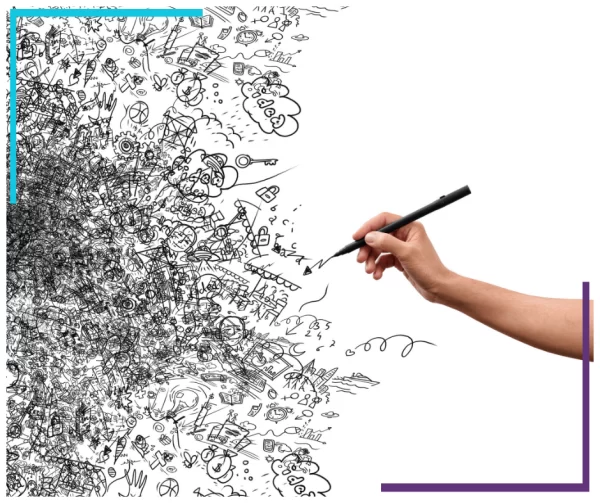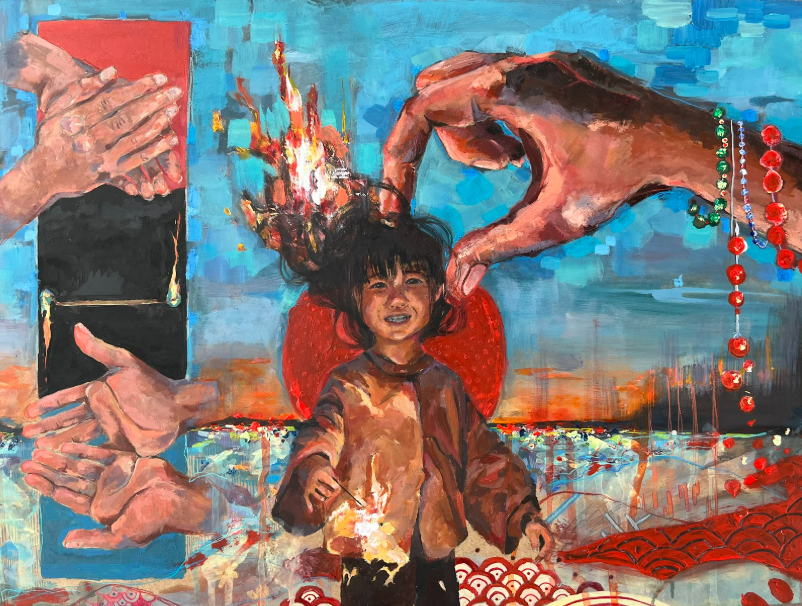The simple act of doodling has been a creative outlet for humans for longer than one might think. Impressively enough, one of the first doodles can be traced all the way back 500 thousand years ago: an abstract man-made mark on a shell found in Indonesia. The first thing Man has ever drawn. The creation of this simple marking serves as a reminder that we have always been creative individuals with the need to express ourselves, but the expression doesn’t have to be limited to Picasso’s Guernica, or Van Gogh’s Starry Night. From rock slabs to math sheets, doodles have persisted throughout our history. Though the world is constantly changing, humans continue to create on the fundamental fact that imagination will always find a way to run wild.
They are certainly more than their dictionary definition—“a scribble made absentmindedly.” Jackie Andrade, a student of psychology from Plymouth University, conducted a study in 2009 in which 40 people had to listen to a mundane phone call—half of them were given the task of drawing random shapes as they listened, and the other half were instructed to simply listen and do nothing else. When the phone call was over, those who doodled were able to retain 29% more of the information fed to them in the phone call than those who did not. Neither group was told that they would be tested on memory. This wasn’t just a coincidence. During an interview about doodling in 2012, Michiko Maruyama, a medical student at the University of British Columbia, uses doodling and drawing as a technique to help her memorize and synthesize new learning. After reviewing what she learned from a lecture, Maruyama draws a “daily doodle”, which is simply a drawing on an index card that best represents the new content she has learned. This proves to be an effective strategy for her, as she asserts, “When I look at the daily doodles they trigger my memory. I can take myself back to the time when I was reflecting and drawing the doodle. I also remember what I did that particular day.” Everyone has a unique way of learning and processing information – but for those who are looking for a good method to memorize, doodling is the perfect tool.
A survey conducted by the American Psychological Association displays that 49% of high school students reported feeling a great deal of stress daily. Stress management is an essential tool for teenagers to incorporate into their daily lives and bring with them beyond their education, and doodling might be an effective addition. Work that students find hard to engage in can be easily bedazzled by small drawings on/near any unwanted worksheet that they are handed. In fact, creating art in any form is proven to lower levels of cortisol, the hormone responsible for stress. Forming patterns of lines or shapes helps the body fall into a rhythm, pulling the mind out of a previously intense, cluttered environment.
Doodling is for everyone–teachers and students alike can channel their inner artists. Ms. Schmidt, one of the art teachers in Greeley, believes that doodling is the perfect tool to use in the classroom. Being an art teacher, she is well-versed in the world of imagination and how students can use it to help their learning. She encourages students to allow their imagination to flow and use whatever method helps them best to learn, including doodling. “I do think it’s enabling this idea of a blank canvas where students can freely explore, retain information, focus themselves, feel calm, feel rejuvenated…” When asked about her personal school experience, Ms. Schmidt replied, “It didn’t distract me. It really helped.”

While doodling is accessible to all, it may not be for everybody, which is okay! For some, doodling can be detrimental to staying focused as their attention is redirected to the drawings on their work. Mrs. Dalton, an English teacher at Greeley, recognizes that doodling may be more beneficial depending on the learner, whether or not students are working individually or in a group setting. For example, some individuals may be visual learners, so doodling and other visual aids are likely to help with retaining knowledge, but in group settings, a student may be easily distracted and disconnected from class. “With experience, I’m seeing more and more of the benefits of multi-learning, such as drawing or doodling to take notes, essentially students creatively reteaching themselves,” Mrs. Dalton explained. Every student is unique in their learning process, and while some students may find doodling to be a powerful tool and the best way to keep the mind engaged, others might find it circumstantially distracting, ultimately leaving it up to the discretion of the individual.
Outside of a school setting, doodles are a way to celebrate one of the most common forms of art. Google Doodle’s 25th birthday just passed, honoring 25 years of doodles in memory of important historical figures, events, artists, holidays, and anniversaries. The annual event that Google holds is a heartwarming reminder to everyone that doodles are an incredible communication tool. Whenever someone had a question they had to look up, they were able to simultaneously learn about whichever Google Doodle the website had displayed for the time being. Some of the most popular and well-liked ones have been Pac-Man’s 30th anniversary, the Rubik’s Cube Game, and Jules Verne’s 183rd birthday. Over the years, Google Doodles have evolved to include fun interactive games that serve as both an educational opportunity and a fun way to pass the time. What started as a way to glamorize a logo for the fun of it has shaped itself into an inclusive event that brings communities together in an engaging and educational way.
Five hundred thousand years have come and gone. And since then, humans have moved on from cave paintings, shells, and rock art to pencil and paper, to a new medium–the electronic device. The digital age is something that has inevitably shaped human life on Earth in incredible ways since its rise in modern society. Doodling is no exception to this change. Now that digital art is widely available on almost every technological device (search ‘drawing’ in the app store and watch as thousands of results come up) and work is being more digitized than ever, it’s no big surprise that doodles have found a new home within the screens. Around Horace Greeley, the breakout rooms with large screens are a perfect place to make drawings while doing work. They can be just as easily erased as they are created, and they give students practice with new doodling mediums.
As Pablo Picasso once said; “All children are artists. The problem is how to remain one once we grow up.” Whether students are interested in art or have never even thought about drawing, doodling is something everybody can try out. After all, there are no rules. If the interest in doodling just isn’t there, that’s alright too! Every person is free to work in whichever way is most comfortable for them, and whether doodling is naturally alluring or completely taboo, art is something that everyone, everywhere, can make.





